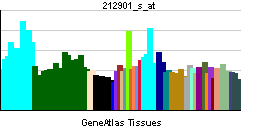CSTF2T
| Cleavage stimulation factor, 3' pre-RNA, subunit 2, 64kDa, tau variant | |||||||||||||
|---|---|---|---|---|---|---|---|---|---|---|---|---|---|
|
File:PBB Protein CSTF2T image.jpg PDB rendering based on 1p1t. | |||||||||||||
| |||||||||||||
| Identifiers | |||||||||||||
| Symbols | CSTF2T ; CstF-64T; DKFZp434C1013; KIAA0689 | ||||||||||||
| External IDs | Template:MGI HomoloGene: 80230 | ||||||||||||
| |||||||||||||
| RNA expression pattern | |||||||||||||
 | |||||||||||||
 | |||||||||||||
| More reference expression data | |||||||||||||
| Orthologs | |||||||||||||
| Template:GNF Ortholog box | |||||||||||||
| Species | Human | Mouse | |||||||||||
| Entrez | n/a | n/a | |||||||||||
| Ensembl | n/a | n/a | |||||||||||
| UniProt | n/a | n/a | |||||||||||
| RefSeq (mRNA) | n/a | n/a | |||||||||||
| RefSeq (protein) | n/a | n/a | |||||||||||
| Location (UCSC) | n/a | n/a | |||||||||||
| PubMed search | n/a | n/a | |||||||||||
Cleavage stimulation factor, 3' pre-RNA, subunit 2, 64kDa, tau variant, also known as CSTF2T, is a human gene.[1]
References
Further reading
- Maruyama K, Sugano S (1994). "Oligo-capping: a simple method to replace the cap structure of eukaryotic mRNAs with oligoribonucleotides". Gene. 138 (1–2): 171–4. PMID 8125298.
- Bonaldo MF, Lennon G, Soares MB (1997). "Normalization and subtraction: two approaches to facilitate gene discovery". Genome Res. 6 (9): 791–806. PMID 8889548.
- Suzuki Y, Yoshitomo-Nakagawa K, Maruyama K; et al. (1997). "Construction and characterization of a full length-enriched and a 5'-end-enriched cDNA library". Gene. 200 (1–2): 149–56. PMID 9373149.
- Ishikawa K, Nagase T, Suyama M; et al. (1998). "Prediction of the coding sequences of unidentified human genes. X. The complete sequences of 100 new cDNA clones from brain which can code for large proteins in vitro". DNA Res. 5 (3): 169–76. PMID 9734811.
- Dass B, McMahon KW, Jenkins NA; et al. (2001). "The gene for a variant form of the polyadenylation protein CstF-64 is on chromosome 19 and is expressed in pachytene spermatocytes in mice". J. Biol. Chem. 276 (11): 8044–50. doi:10.1074/jbc.M009091200. PMID 11113135.
- Wiemann S, Weil B, Wellenreuther R; et al. (2001). "Toward a catalog of human genes and proteins: sequencing and analysis of 500 novel complete protein coding human cDNAs". Genome Res. 11 (3): 422–35. doi:10.1101/gr.154701. PMID 11230166.
- Simpson JC, Wellenreuther R, Poustka A; et al. (2001). "Systematic subcellular localization of novel proteins identified by large-scale cDNA sequencing". EMBO Rep. 1 (3): 287–92. doi:10.1093/embo-reports/kvd058. PMID 11256614.
- Dass B, McDaniel L, Schultz RA; et al. (2003). "The gene CSTF2T, encoding the human variant CstF-64 polyadenylation protein tauCstF-64, lacks introns and may be associated with male sterility". Genomics. 80 (5): 509–14. PMID 12408968.
- Strausberg RL, Feingold EA, Grouse LH; et al. (2003). "Generation and initial analysis of more than 15,000 full-length human and mouse cDNA sequences". Proc. Natl. Acad. Sci. U.S.A. 99 (26): 16899–903. doi:10.1073/pnas.242603899. PMID 12477932.
- Pérez Cañadillas JM, Varani G (2003). "Recognition of GU-rich polyadenylation regulatory elements by human CstF-64 protein". EMBO J. 22 (11): 2821–30. doi:10.1093/emboj/cdg259. PMID 12773396.
- Beausoleil SA, Jedrychowski M, Schwartz D; et al. (2004). "Large-scale characterization of HeLa cell nuclear phosphoproteins". Proc. Natl. Acad. Sci. U.S.A. 101 (33): 12130–5. doi:10.1073/pnas.0404720101. PMID 15302935.
- Gerhard DS, Wagner L, Feingold EA; et al. (2004). "The status, quality, and expansion of the NIH full-length cDNA project: the Mammalian Gene Collection (MGC)". Genome Res. 14 (10B): 2121–7. doi:10.1101/gr.2596504. PMID 15489334.
- Zhao X, Oberg D, Rush M; et al. (2005). "A 57-nucleotide upstream early polyadenylation element in human papillomavirus type 16 interacts with hFip1, CstF-64, hnRNP C1/C2, and polypyrimidine tract binding protein". J. Virol. 79 (7): 4270–88. doi:10.1128/JVI.79.7.4270-4288.2005. PMID 15767428.
- Rual JF, Venkatesan K, Hao T; et al. (2005). "Towards a proteome-scale map of the human protein-protein interaction network". Nature. 437 (7062): 1173–8. doi:10.1038/nature04209. PMID 16189514.
- Lim J, Hao T, Shaw C; et al. (2006). "A protein-protein interaction network for human inherited ataxias and disorders of Purkinje cell degeneration". Cell. 125 (4): 801–14. doi:10.1016/j.cell.2006.03.032. PMID 16713569.
| This protein-related article is a stub. You can help Wikipedia by expanding it. |